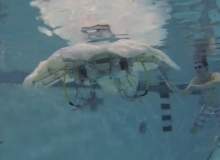

Discover B2B Marketing That Performs
Combine business intelligence and editorial excellence to reach engaged professionals across 36 leading media platforms.
Biomimetics, or using inspiration from nature to design novel technology, has resulted in military robots that can move faster, such as Boston Dynamics’ Cheetah, or in new ways, sneaking into tiny spaces, like AeroVironment’s Nano Hummingbird UAV or Georgia Tech’s Scalybot snake robot. As they become ever more lifelike, one advantage of making robots that look like animals is invcreasingly coming to the fore – they can hide in plain sight among their natural brethren.
This is never truer than in the vast volume of ocean waters. Though submarines or unmanned underwater vehicles (UUVs) would soon ping up on a sonar or radar search of a monitored area, who would look twice at a jellyfish cruising through?
This video shows Virginia Tech researchers taking the 170 pound, five foot seven inch Cyro robotic jellyfish for a swim, demonstrating its lifelike undulating method of locomotion. Cyro is based on a pint-sized technology demonstrator predecessor, the RoboJelly, built by the same team headed by Shashank Priya.
Cyro is the result of a multi-university US$5m project, funded by US Naval Undersea Warfare Center and the Office of Naval Research, to develop self-powering, autonomous robots to carry out surveillance and monitoring, as well as gathering environmental and biological data.

US Tariffs are shifting - will you react or anticipate?
Don’t let policy changes catch you off guard. Stay proactive with real-time data and expert analysis.
By GlobalDataJellyfish surveillance: how to slip through the net
The jellyfish format is an attractive one for robot researchers to mimic as it uses very little energy, and the increased size uses even less, as well as enabling a larger payload to collect, store, analyse and communicate sensory data, both important factors for lurking surveillance. Cyro is powered by a rechargeable nickel metal hydride battery, and could pulsate its way around the ocean for months at a time before needing to be recharged.
Cyro is currently a prototype, and years away from being used in open waters. A new prototype is already under development, which the researchers hope will demonstrate reduced power consumption and look and behave even more like a natural jellyfish.
Cyro is currently propelled using a rigid support structure with direct current electric motors to control the mechanical arms, used in conjunction with an artificial silicon mesoglea, the jelly-based pulp of the fish’s body, creating hydrodynamic movement. Future versions could demonstrate an even greater natural motion using a bio-inspired control system to mimic a jellyfish’s diffused neural net.
"It has been a great experience to finally realise the biomimetic and bio-inspired robotic vehicles," Priya said. "Nature has too many secrets and we were able to find some of them but many still remain. We hope to find a mechanism to continue on this journey and resolve the remaining puzzles."
Related content
Grace under pressure – the US Navy’s search for a lightweight diving suit
The US Navy wants its divers to operate at unprecedented ocean depths in a lightweight, agile, swimmable diving suit without resorting to lengthy decompression procedures.
Video feature: Raytheon multilayered offshore defence offering gets animated
Navies worldwide are responding to dangers of piracy against shipping and terrorist threats on drilling platforms by investing in fleets of offshore patrol vessels, aircraft and unmanned aerial systems (UAS).
Follow Berenice Baker on Google+


.gif)


